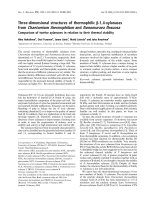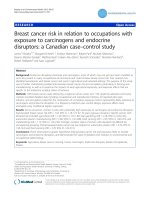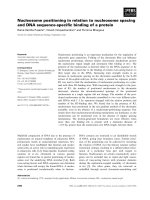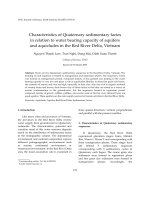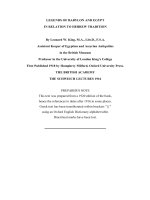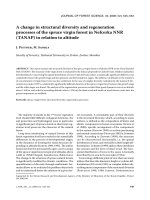Profitability and risk in relation to income diversification of Vietnamese commercial banking system
Bạn đang xem bản rút gọn của tài liệu. Xem và tải ngay bản đầy đủ của tài liệu tại đây (582.17 KB, 16 trang )
Vo Xuan Vinh & Tran Thi Phuong Mai / Journal of Economic Development 23(2) 61-76
61
Profitability and Risk in Relation to Income
Diversification of Vietnamese Commercial
Banking System
VO XUAN VINH
University of Economics HCMC –
TRAN THI PHUONG MAI
Asia Commercial Bank –
ARTICLE INFO
ABSTRACT
Article history:
Employing a panel data set including 37 joint-stock commercial banks
covering the period from 2006 to 2013, this paper investigates the
impact of income diversification on bank risk and returns. Our results
show that increased income diversification results in higher rates of
bank returns. However, when risk is considered, the increased income
diversification leads to lower risk-adjusted returns. Empirical
evidence also shows that the income diversification is not beneficial
to joint-stock commercial banks in Vietnam.
Received:
Jan. 27 2015
Received in revised form:
Aug. 20 2015
Accepted:
Mar. 25 2016
Keywords:
Income diversification,
bank, returns, risk.
62
Vo Xuan Vinh & Tran Thi Phuong Mai / Journal of Economic Development 23(2) 61-76
1. Introduction
Since the early 2000s commercial banks in the world tend to diversify their activities,
caused by competitive pressures or the profits from financial investment (DeYoung &
Roland, 2001). In Vietnam, due to a considerable increase in the number of commercial
banks, there has been increasingly fierce competition between these banks, starting from
2006. In addition, the Vietnamese commercial banks have to perform against foreign
ones, and the competition tends to be more intense when 100% foreign ownership is
allowed in the national banking system. Furthermore, financial firms, with their
significantly increasing number and size, in recent times have been connected to harsher
competitiveness, which causes marginal revenue from traditional credit operations to
have increasingly been shrinking.
The years of 2006–2007 saw a boom in stock market operations, and stock investment
generated huge profits for market participants. Also during this period bank-affiliated
firms operating in finance/stock domain contributed to capital and stock investments,
bringing in higher noninterest income. High returns did seemingly enable banks to
follow the strategy of income diversification as the proportion of their interest income
fell.
However, the financial crisis, which lately led to several problems of contracted total
demand of the economy, increased inventories, frozen real estate, stagnant production,
and so on, has created numerous difficulties for Vietnamese enterprises, indirectly
influenced bank performance, and particularly caused more nonperforming loans. In this
period more loss provisions were required, which were sharply reducing banks’ revenue
from credit activities.
On the other hand, point losses in the stock market and reduction in market liquidity
are other causes to increased risk posed to bank investments in nontraditional activities.
In addition, the central bank increasingly tightened banks’ risk management by means
of specific regulations on risk prevention, enacted and modified to control banking
activities. The level of loss provisions was also increased to prevent the effects of
nonperforming loans on reducing banks' profits.
From another aspect the difficulties in lending activities, together with new
regulations on control over credit activities, have forced banks to potentially diversify
income sources so as to proceed with other activities in search of new opportunities.
Noninterest income previously came from service charges from checks and trust or asset
Vo Xuan Vinh & Tran Thi Phuong Mai / Journal of Economic Development 23(2) 61-76
63
management services. Recently banking activities have expanded to include insurance,
commercial investment, and others; hence, with the expansion of non-traditional
activities, banks can realize their moves into a wider market segment in addition to
higher earnings from more diversified sources. Nonetheless, changes in the economy in
those past years have significantly impacted on the profitability and risk involving the
banking sector.
A stream of research in the world has probed the impact of diversification of bank
risk and profitability, the findings of which, however, are not consistent and perceived
with great discrepancies (Gurbuz et al., 2013; Lee et al., 2014; Niu, 2012; Pennathur et
al., 2012; Sanya & Wolfe, 2011; Wagner, 2010). In fact, many of the commercial banks
in Vietnam have implemented the strategy of income diversification over the past ten
years despite fewer studies conducted to academically ponder the issue. As a
contribution to the existing assessment of bank performance, accordingly, we consider
the income diversification with its effects on the risk and profitability among Vietnamese
commercial banks by addressing how the diversification affects the others.
2. Literature review and hypotheses
2.1. Diversification and bank profitability
Theoretically, one of the issues, which has been extensively studied but still reflects
inconsistent outcomes, is whether diversification ever increases bank profitability in a
stable and sustainable manner. Many researches showed that adopting an income
diversification strategy leads to increase in bank profits. Smith et al. (2003) pointed out
that more concentration on non-interest income generation will contribute to stabilizing
the bank profitability. Chiorazzo et al. (2008) reported the diversification of non-interest
income resulting in profit increase, which is supported by other studies with various
datasets in different countries (Baele et al., 2007; Carlson, 2004; Elsas et al., 2010;
Gurbuz et al., 2013; Landskroner et al., 2005).
Nevertheless, many empirical studies refuted the profit-related approach when banks
attempt to diversify their income sources (DeYoung & Roland, 2001; Stiroh, 2004a,
2006; Stiroh & Rumble, 2006). Particularly, DeYoung and Roland (2001) analyzed the
risk of losing customers during banks’ involvement in activities that provide more
income from charges than from the lending ones. Notwithstanding a great sensitivity
between interest rates and recession, income from traditional activities remains stable
64
Vo Xuan Vinh & Tran Thi Phuong Mai / Journal of Economic Development 23(2) 61-76
over time as switching and information costs should cause it to be costly for both
borrowers (customers) and lenders (banks), when loans are to be arranged with other
banking institutions. For this reason the credit relationship between the customer and the
bank reflects little changes. In another research Stiroh (2004a) highlighted a high
correlation between interest income growth and non-interest income growth in the
1990s, yet the latter reveals more volatilities than the former and reduces the trading
income. Additionally, the study indicated a negative relation between non-interest
income and returns.
One defining characteristic of Vietnam’s commercial banks is their increasing
number, resulting from a series of banks in rural areas upgraded to joint-stock
commercial banks; thus, income diversification may be highly beneficial to these. From
the above analyses and prior discussions on the diversification, profitability, and the
specific case of Vietnam, we suggest the following hypothesis.
H1: The higher level of income diversification is associated with higher returns.
2.2. Diversification and bank risk
With respect to the risk to diversification of banking activities and from a
conventional wisdom in the finance and banking industry, non-interest income that
comes from service charges often proves more stable than interest income; hence, bank
risk reduction can be achieved (DeYoung & Roland, 2001). Chiorazzo et al. (2008) and
Lee et al. (2014) argued for the likelihood of reduction in bank risk via income
diversification.
All the same, the opposite view has been supported in many studies, which imply that
income diversification may entail increased risk among commercial banks. The reason
is such that loan-based income may be stable over time because customers are afraid of
a shift in credit relationship (switching and information costs are required in the event
of changes in lending relationship), while non-interest income is likely to become highly
volatile because banks can easily shift to lending activities. Moreover, banks expand
their activities for non-interest income, and this will involve increased fixed costs,
leading to increased operating leverage and higher risk (DeYoung & Roland, 2001). This
argument is further supported in many empirical studies, such as Lepetit et al. (2008)
and Baele et al. (2007).
Vo Xuan Vinh & Tran Thi Phuong Mai / Journal of Economic Development 23(2) 61-76
65
In the past many Vietnamese commercial banks attempted to diversify income
sources through risky investments in real estate and stocks or through the establishment
of a series of subsidiaries and associate companies. Expansion into new areas involving
high risk without sufficient experience leads to more serious risk posed to these banks
and reduced risk-adjusted returns. Thus, another hypothesis can be formulated on the
ground of distinctive commercial banks in Vietnam and the above discussion.
H2: The higher level of income diversification is associated with higher risk, but
lower risk-adjusted returns.
3. Data and methodology
3.1. Research data
The data was collected from the audited, annually reported, and prospectus- and noteincluded financial statements of 37 Vietnam’s commercial banks in 2006–2013, which
consist of one state bank1 and 36 joint-stock commercial banks. The dataset does not
include the Vietnam Bank for Social Policies, the Vietnam Development Bank, five
100% foreign-owned banks, four joint-venture banks, one cooperative bank (formerly
the Central People's Credit Fund), and five merged banks2. We perform a regression
using unbalanced panel data.
3.2. Diversification measurement
In this study we examine income diversification based on bank income structure,
including interest and non-interest income. If a bank’s revenue comes only from netinterest income, then it is characterized as being concentrated, whereas that from both
interest and non-interest sources is considered to be diversified, and the diversification
of two main bank income sources is measured by HHI_REV, an indicator of changes in
bank income (Elsas et al., 2010; Gurbuz et al., 2013; Sanya & Wolfe, 2011; TrujilloPonce, 2013), calculated as follows:
𝑁𝑂𝑁 2
𝑁𝐸𝑇 2
𝐻𝐻𝐼_𝑅𝐸𝑉 = (
) + (
)
𝑁𝐸𝑇𝑂𝑃
𝑁𝐸𝑇𝑂𝑃
where NON represents non-interest income, measured by total income from fees and
commissions from service streams, foreign exchange and gold trading, trading and
66
Vo Xuan Vinh & Tran Thi Phuong Mai / Journal of Economic Development 23(2) 61-76
investment stock transactions, capital raising, and share purchases; NET is net interest
income; and NETOP is net operating income, estimated by a sum of non-interest income
and net interest income (NETOP = NON and NET).
Modelling the impact
Similar to Sanya & Wolfe (2011), we focus on profitability and risk with respect to
commercial banks’ income diversification through the equations presented as follows:
𝑃𝑟𝑜𝑓𝑖𝑡𝑎𝑏𝑖𝑙𝑖𝑡𝑦𝑖𝑡 = 𝛼0 + 𝛼1 ∗ 𝐻𝐻𝐼𝑅𝐸𝑉 𝑖𝑡 + 𝛼2 ∗ 𝐿𝐴 𝑖𝑡 + 𝛼3 ∗ 𝑆𝐼𝑍𝐸𝑖𝑡
+𝛼4 ∗ 𝐴𝑆𝑆𝐸𝑇_𝐺𝑅𝑂𝑖𝑡 + 𝛼5 ∗ 𝐷𝑃𝑆_𝑇𝐴𝑖𝑡 + 𝛼6 ∗ 𝐺𝐿_𝐺𝑅𝑂𝑖𝑡 + 𝜀𝑖𝑡
𝑅𝑖𝑠𝑘_𝐴𝑑𝑗𝑢𝑠𝑡𝑒𝑑_𝑃𝑟𝑜𝑓𝑖𝑡𝑎𝑏𝑖𝑙𝑖𝑡𝑦𝑖𝑡
= 𝛾0 + 𝛾1 ∗ 𝐻𝐻𝐼_𝑅𝐸𝑉𝑖𝑡 + 𝛾2 ∗ 𝐿_𝐴𝑖𝑡 + 𝛾3 ∗ 𝑆𝐼𝑍𝐸𝑖𝑡 + 𝛾4
∗ 𝐴𝑆𝑆𝐸𝑇_𝐺𝑅𝑂𝑖𝑡 + 𝛾5 ∗ 𝐷𝑃𝑆_𝑇𝐴𝑖𝑡 + 𝛾6 ∗ 𝐺𝐿_𝐺𝑅𝑂𝑖𝑡 + 𝜀𝑖𝑡
where:
Profitabilityit: an indicator of bank profits, measured by ROAA and ROAE at the end
of year t of bank i—ROAA is the ratio of return to total average assets of the bank,
representing profitability or income generating effect of bank assets and calculated by
the aggregate profit before tax as a ratio to average total assets of the two consecutive
years at the end of the financial year (Chiorazzo et al., 2008; Grossman, 1994; Lee et al.,
2014), and ROAE, estimated by after-tax income as a ratio to average equity of the two
consecutive years at the end of the financial year (Lee et al., 2014; Trujillo-Ponce, 2013).
Risk_Ajusted_Profitabilityit: an indicator of bank risk, measured by RAROA,
RAROE, and Z_SCORE of bank i in year t and thus computed as follows:
RAROAit =
ROAit
ϬROAit
RAROEit =
ROEit
ϬROEit
Z_SCOREit =
ROAit + E_Ait
ϬROAit
L_Ait: an indicator of loans, estimated using total loans as a ratio to total assets of
bank i in year t (DeYoung & Roland, 2001; DeYoung & Rice, 2004; Stiroh, 2004b;
Stiroh & Rumble, 2006).
Vo Xuan Vinh & Tran Thi Phuong Mai / Journal of Economic Development 23(2) 61-76
67
SIZEit: size of bank i in year t, calculated by total assets in natural logarithm (in
million VND) at the end of the financial year (Acharya et al., 2006; Gurbuz et al., 2013;
Lee et al., 2014; Sanya & Wolfe, 2011).
ASSET_GROit: an indicator of asset growth of bank i in year t, measured by the ratio
of growth in total assets in the current year to that in the previous year; using
ASSET_GROW in the model is to control for the effect of rapid expansion on the
profitability as well as bankruptcy risk of the bank (Lee et al., 2014; Sanya & Wolfe,
2011).
DPS_TAit: a variable to reflect the deposit level of bank i in year t, measured by the
ratio of total deposits to total assets (Lei & Song, 2013; Lepetit et al., 2008).
GL_GROit: the level of gross loan growth of bank i in year t, calculated by loan
growth in the current year compared to that in the previous year (%)
εit: unobserved error term of bank i in year t.
Table 1
Description of variables included in the analysis
Variable
Description
Measured by
Return
ROAA
Return on average assets (%)
Profit before tax/[(total assets in year t
+ total assets in year t-1)/2]
ROAE
Return on average equity (%)
Profit after tax/[(equity in year t +
equity in year t-1)/2]
RAROA
Risk-adjusted ROA (%)
ROA/ϬROA
RAROE
Risk-adjusted ROE (%)
ROE/ϬROE
Risk-adjusted return
Z_SCORE
(ROA + E_A)/ϬROA
68
Vo Xuan Vinh & Tran Thi Phuong Mai / Journal of Economic Development 23(2) 61-76
Variable
Description
Measured by
Income diversification
Diversification of revenue
(NON/NETOP)2 + (NET/NETOP)2
L_A
Loan/asset ratio
Total loans/total assets
SIZE
Bank size
Ln(total assets)
ASSET_GRO
Rate of asset growth (%)
(Total assets in year t - total assets in
year t-1)/total assets in year t-1
DPS_TA
Deposit rate
Total deposits/total assets
GL_GRO
Rate of loan growth (%)
(Loan in year t - loan in year t-1)/loan
in year t-1
HHI_REV
Control variables
3.3. Estimation methods
We adopt the common techniques in panel data regression. First, we use the Hausman
test to decide between fixed and random effects estimators. The test results show that
the calculated chi-square value for the equations of ROAA and ROAE is less than 5%;
hence, we employ the fixed effects estimator for regression of these dependent variables.
Given the equations of RAROA, RAROE, and Z_SCORE, the chi-square value is higher
than 5%, so the random effects estimator can be applied to regression of these three
variables. Additionnaly, the use of GMM estimator, an optimal technique to handle
endogeneity, is to improve reliability of the research methods.
4. Results and discussion
Table 2 summarizes the statistical description of the variables employed in this study.
Table 2
Statistical description of variables
Variable
Mean
Max
Min
Std. dev.
0.0176
0.0716
0.0002
0.0122
Return
ROAA
69
Vo Xuan Vinh & Tran Thi Phuong Mai / Journal of Economic Development 23(2) 61-76
Variable
Mean
Max
Min
Std. dev.
0.1154
0.4449
0.0007
0.0705
RAROA
2.8556
17.4368
0.0206
2.6080
RAROE
2.7429
10.7717
0.0158
1.9308
Z_SCORE
27.5960
226.7730
5.4816
27.5132
Income
diversification
Income diversification
HHI_REV
0.7608
2.8541
0.5002
0.2574
L_A
0.5153
0.9442
0.1138
0.1518
SIZE
17.2490
20.1723
13.0115
1.4664
ASSET_GRO
0.6170
12.6611
-0.4069
1.2180
DPS_TA
0.8340
0.9477
0.3628
0.0936
GL_GRO
0.5709
11.3173
-0.4076
1.1830
ROAE
Risk-adjusted return
Bank characteristics
Table 3 presents correlation coefficient matrix of the variables in the model. The
correlation coefficients are used for testing the presence of multicollinearity among the
variables. The results indicate that no pairs produce the absolute value of larger than 0.8;
thus, we can conclude that there is no strong possibility that the multicollinearity exists
due to rather small values of most of the correlation coefficients.
ROAA
1
ROAE
0.480
RAROA
0.266 0.431
1
1
GL_GRO
DPS_TA
ASSET_GRO
SIZE
L_A
HHI_REV
Z_SCORE
RAROE
RAROA
ROAE
ROAA
Table 3
Correlation coefficient matrix of variables
70
Vo Xuan Vinh & Tran Thi Phuong Mai / Journal of Economic Development 23(2) 61-76
RAROE
0.258 0.558
0.843
1
Z_SCORE
0.072 -0.043 0.781 0.485
HHI_REV
-0.139 -0.236 -0.147 -0.158 -0.055
L_A
0.103 -0.026 0.022 0.033 0.004 -0.013
SIZE
-0.465 0.285
1
1
1
0.121 0.261 -0.116 -0.113 -0.060
1
ASSET_GRO 0.287 0.089
0.006 0.016 0.020 -0.119 -0.223 -0.291
1
DPS_TA
-0.542 0.210
0.051 0.206 -0.159 -0.139 -0.119 0.648 -0.116
GL_GRO
0.229 0.080
0.006 0.034 0.005 -0.142 -0.117 -0.245 0.751 -0.085
1
1
Table 4 shows the regression results with fixed effects and GMM estimators for panel
data; two of the dependent variables that proxy for bank returns are ROAA and ROAE.
The coefficient of income diversification, as indicated, is negative and statistically
significant at 1% level. Hence, the diversification is found to increase profits, and we
can accept the hypothesis that the higher level of the income diversification leads to
higher returns (H1).
Table 4
Estimated results with ROAA and ROAE as two dependent variables
ROAA
Variable
C
Fixed effects
Coef.
p-value
0.139
0.000
Lag(-1)
ROAE
GMM
Coef.
p-value
0.366
0.000
Fixed effects
Coef.
p-value
0.470
0.000
GMM
Coef.
p-value
0.649
0.000
HHI_REV
0.010
0.000
-0.019
0.000
-0.038
0.023
-0.057
0.000
L_A
0.003
0.620
-0.010
0.021
-0.108
0.012
0.027
0.537
SIZE
0.005
0.000
-0.001
0.130
-0.025
0.000
0.018
0.000
ASSET_GRO
0.001
0.122
-0.003
0.000
0.001
0.874
0.014
0.144
71
Vo Xuan Vinh & Tran Thi Phuong Mai / Journal of Economic Development 23(2) 61-76
ROAA
Variable
Fixed effects
ROAE
GMM
Fixed effects
GMM
Coef.
p-value
Coef.
p-value
Coef.
p-value
Coef.
p-value
DPS_TA
0.028
0.009
-0.017
0.047
0.180
0.006
-0.072
0.550
GL_GRO
0.001
0.510
0.007
0.000
0.007
0.154
0.028
0.000
R2
0.617
0.576
Adjusted R2
0.536
0.486
Prob
(F-statistic)
0.000
0.000
J-statistic
28.121
24.061
Prob(jstatistic)
0.107
0.240
AR(1)
0.000
0.004
AR(2)
0.591
0.817
Regarding risk-adjusted return, Table 5 demonstrates the results of regression using
random effects and GMM estimators with such two dependent variables as RAROA and
RAROE. Also evidenced by the table, the regression coefficients of HHI_REV for the
two cases of RAROA and RAROE are negative and statistically significant at 1% level,
implying that the higher level of income diversification results in higher risk yet lower
risk-adjusted profits.
Table 5
Estimated results with RAROA and RAROE as two dependent variables
RAROA
Variable
C
Lag(-1)
Random effects
Coef.
p-value
12.517
0.000
RAROE
GMM
Coef.
0.166
p-value
0.040
Random effects
Coef.
p-value
5.206
0.007
GMM
Coef.
p-value
0.343
0.000
72
Vo Xuan Vinh & Tran Thi Phuong Mai / Journal of Economic Development 23(2) 61-76
RAROA
Variable
Random effects
RAROE
GMM
Random effects
GMM
Coef.
p-value
Coef.
p-value
Coef.
p-value
Coef.
p-value
HHI_REV
-0.704
0.011
-1.171
0.000
-0.732
0.017
-1.243
0.000
L_A
-1.033
0.140
-3.280
0.001
-1.784
0.024
-2.110
0.125
SIZE
-0.403
0.000
-0.138
0.254
-0.242
0.022
0.026
0.817
ASSET_GRO
-0.003
0.975
-0.288
0.032
-0.062
0.498
-0.012
0.964
DPS_TA
-1.856
0.088
-2.036
0.213
3.734
0.002
3.131
0.109
GL_GRO
0.078
0.358
0.726
0.000
0.184
0.051
0.533
0.039
R2
0.181
0.805
Adjusted R2
0.160
0.764
Prob
(F-statistic)
0.000
0.000
J-statistic
28.115
25.497
Prob
(j-statistic)
0.107
0.183
AR(1)
0.000
0.000
AR(2)
0.591
0.167
The results of regression using fixed effects and GMM estimators with Z_SCORE as
a dependent variable and a proxy for risk-adjusted return (Table 6) indicate that the
coefficients of income diversification are negative and not statistically significant for the
fixed effects estimator, yet are positive and significant at 10% level for the GMM
estimator. Accordingly, in terms of Z_SCORE, the results are quite contradictory for the
income diversification in its relation to bank profitability and risk.
Vo Xuan Vinh & Tran Thi Phuong Mai / Journal of Economic Development 23(2) 61-76
73
Table 6
Estimated results with Z_SCORE as a dependent variable
Variable
C
Fixed effects
GMM
Coef.
p-value
136.217
0.000
Z_SCORE(-1)
Coef.
p-value
-0.156
0.000
HHI_REV
-0.544
0.761
1.734
0.070
L_A
3.463
0.453
22.841
0.000
SIZE
-1.759
0.005
-2.160
0.013
ASSET_GRO
0.922
0.087
4.657
0.000
DPS_TA
-96.501
0.000
-100.114
0.000
GL_GRO
-1.080
0.052
-4.793
0.000
R2
0.956
Adjusted R2
0.947
Prob(F-statistic)
0.000
J-statistic
19.469
Prob(j-statistic)
0.492
AR(1)
0.095
AR(2)
0.328
Nevertheless, most of the findings obtained from Table 5 allow us to accept the
hypothesis that the higher level of income diversification is associated with higher risk,
but lower risk-adjusted returns (H2).
5. Conclusion and implications
5.1. Conclusion
One of the issues that captures scant attention of different individuals, such as bank
managers or policy makers, is the diversification of banking activities. As a contribution
to the theoretical and practical debates, in this study we have considered the issue from
74
Vo Xuan Vinh & Tran Thi Phuong Mai / Journal of Economic Development 23(2) 61-76
the perspectives of bank profitability and risk. Using the panel data for the 2006–2013
period in addition to other common regression techniques, we find that Vietnam’s
commercial banks, with expansion into diversified non-interest generating activities, do
earn higher returns. Still, if bank risk is taken into account, the income diversification
causes a lower level of risk-adjusted returns, whereas the banks face greater risk than
those benefiting from traditional income sources.
5.2. Implications
This study also proposes several implications for bank managers and policy makers
in their orienting the national commercial banks’ performance.
Firstly, given bank managers, empirical evidence has been provided of the relations
existing among profitability, risk, and income diversification, based on which effective
strategies can be devised. It is suggested that the diversified bank performance leads to
lower risk-adjusted profits and higher profits if risk is and is not considered respectively,
which is significant to banks’ diverfication practices. During the stated process the factor
of risk should be addressed for the managers’ adopting coherent business strategies
aimed at the optimal income generation and reduced bank risk.
Secondly, as indicated by the findings, banks during diversification facing the
challenge of high risk should focus on traditional income generation activities.
Implementing such, on the one hand, proves that the banks function properly, and on the
other hand, clearly defines the role of commercial banking system in the economy.
Moreover, bank managers should improve their governance performance, and modern
technologies are to be adopted to increase profits and reduce risk for the commercial
banks. Particularly, small-scale banks should enhance the quality of capital mobilization
and traditional lending activities, in which it is important to focus on a specific group of
customers from whom they gain advantage, rather than the diversification into other
potentially riskier services.
Thirdly, a few implications can be suggested for policy makers in various banking
regulatory agencies. Since no increase in bank returns is reflected when risk is involved,
this implies that they are supposed to adopt measures that limit bank expansion into nonbanking activities, especially into high-risk investments as in real estate or stock market
as well as others in which no experience and advantages can be gained. More
importantly, policy makers need to have strict policies to restrict the use of bank deposits
in the risky investments as were mentioned
Vo Xuan Vinh & Tran Thi Phuong Mai / Journal of Economic Development 23(2) 61-76
75
Notes
1
The state commercial bank is Vietnam Bank for Agriculture and Rural Development (source: SBV).
2
100% foreign-owned banks are HSBC, Standard Chartered, Shinhan Vietnam, ANZVL, and Hong
Leong; joint-venture banks are VID Public Bank, Indovina Bank Limited, Vinasiam Bank, and
Vietnam-Russia Joint Venture Bank; meged banks include Vietnam Tinnghiabank.
References
Acharya, V. V., Hasan, I., & Saunders, A. (2006). Should banks be diversified? Evidence from
individual bank loan portfolios. The Journal of Business, 79(3), 1355–1412.
Baele, L., De Jonghe, O., & Vander Vennet, R. (2007). Does the stock market value bank
diversification? Journal of Banking & Finance, 31(7), 1999–2023.
Carlson, M. (2004). Are branch banks better survivors? Evidence from the depression era. Economic
Inquiry, 42(1), 111–126.
Chiorazzo, V., Milani, C., & Salvini, F. (2008). Income diversification and bank performance:
Evidence from Italian banks. Journal of Financial Services Research, 33(3), 181–203.
DeYoung, R., & Rice, T. (2004). Noninterest income and financial performance at US commercial
banks. Financial Review, 39(1), 101–127.
DeYoung, R., & Roland, K. P. (2001). Product mix and earnings volatility at commercial banks:
Evidence from a degree of total leverage model. Journal of Financial Intermediation, 10(1), 54–
84.
Elsas, R., Hackethal, A., & Holzhäuser, M. (2010). The anatomy of bank diversification. Journal of
Banking & Finance, 34(6), 1274–1287.
Grossman, R. S. (1994). The shoe that didn't drop: Explaining banking stability during the great
depression. The Journal of Economic History, 54(03), 654–682.
Gurbuz, A. O., Yanik, S., & Ayturk, Y. (2013). Income diversification and bank performance:
Evidence from Turkish banking sector. Journal of BRSA Banking and Financial Markets, 7(1), 9–
29.
Landskroner, Y., Ruthenberg, D., & Zaken, D. (2005). Diversification and performance in banking:
The Israeli case. Journal of Financial Services Research, 27(1), 27–49.
Lee, C. C., Hsieh, M. F., & Yang, S. J. (2014). The relationship between revenue diversification and
bank performance: Do financial structures and financial reforms matter? Japan and the World
Economy, 29, 18–35.
Lei, A. C., & Song, Z. (2013). Liquidity creation and bank capital structure in China. Global Finance
Journal, 24(3), 188–202.
76
Vo Xuan Vinh & Tran Thi Phuong Mai / Journal of Economic Development 23(2) 61-76
Lepetit, L., Nys, E., Rous, P., & Tarazi, A. (2008). Bank income structure and risk: An empirical
analysis of European banks. Journal of Banking & Finance, 32(8), 1452–1467.
Niu, J. (2012). An empirical analysis of the relation between bank charter value and risk taking. The
Quarterly Review of Economics and Finance, 52(3), 298–304.
Pennathur, A. K., Subrahmanyam, V., & Vishwasrao, S. (2012). Income diversification and risk: Does
ownership matter? An empirical examination of Indian banks. Journal of Banking & Finance,
36(8), 2203–2215.
Sanya, S., & Wolfe, S. (2011). Can banks in emerging economies benefit from revenue
diversification? Journal of Financial Services Research, 40(1-2), 79–101.
Smith, R., Staikouras, C., & Wood, G. (2003). Non-interest income and total income stability
(Working Paper No. 198). London, UK: Bank of England.
Stiroh, K. J. (2004a). Diversification in banking: Is noninterest income the answer? Journal of Money,
Credit and Banking, 36(5), 853–882.
Stiroh, K. J. (2004b). Do community banks benefit from diversification? Journal of Financial
Services Research, 25(2-3), 135–160.
Stiroh, K. J. (2006). A portfolio view of banking with interest and noninterest activities. Journal of
Money, Credit and Banking, 38(5), 1351–1361.
Stiroh, K. J., & Rumble, A. (2006). The dark side of diversification: The case of US financial holding
companies. Journal of Banking & Finance, 30(8), 2131–2161.
Trujillo‐Ponce, A. (2013). What determines the profitability of banks? Evidence from Spain.
Accounting & Finance, 53(2), 561–586.
Wagner, W. (2010). Diversification at financial institutions and systemic crises. Journal of Financial
Intermediation, 19(3), 373–386.

